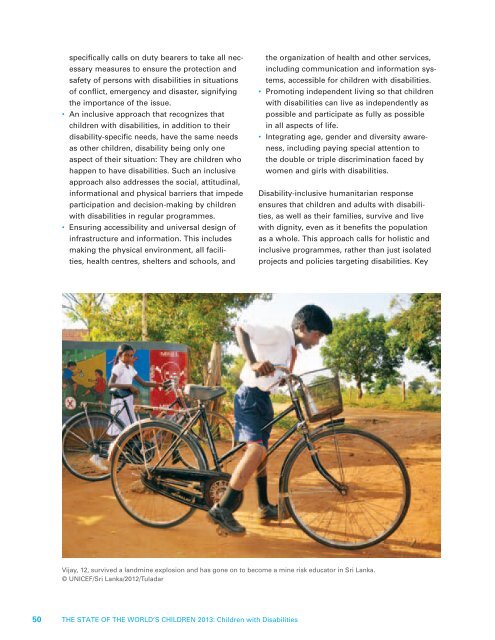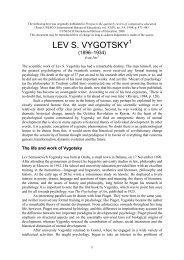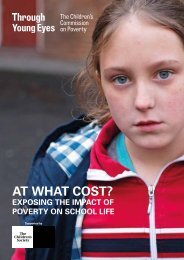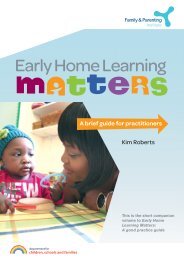Children with Disabilities
Children with Disabilities
Children with Disabilities
Create successful ePaper yourself
Turn your PDF publications into a flip-book with our unique Google optimized e-Paper software.
50<br />
specifically calls on duty bearers to take all necessary<br />
measures to ensure the protection and<br />
safety of persons <strong>with</strong> disabilities in situations<br />
of conflict, emergency and disaster, signifying<br />
the importance of the issue.<br />
• An inclusive approach that recognizes that<br />
children <strong>with</strong> disabilities, in addition to their<br />
disability-specific needs, have the same needs<br />
as other children, disability being only one<br />
aspect of their situation: They are children who<br />
happen to have disabilities. Such an inclusive<br />
approach also addresses the social, attitudinal,<br />
informational and physical barriers that impede<br />
participation and decision-making by children<br />
<strong>with</strong> disabilities in regular programmes.<br />
• Ensuring accessibility and universal design of<br />
infrastructure and information. This includes<br />
making the physical environment, all facilities,<br />
health centres, shelters and schools, and<br />
THE STATE OF THE WORLD’S CHILDREN 2013: <strong>Children</strong> <strong>with</strong> <strong>Disabilities</strong><br />
the organization of health and other services,<br />
including communication and information systems,<br />
accessible for children <strong>with</strong> disabilities.<br />
• Promoting independent living so that children<br />
<strong>with</strong> disabilities can live as independently as<br />
possible and participate as fully as possible<br />
in all aspects of life.<br />
• Integrating age, gender and diversity awareness,<br />
including paying special attention to<br />
the double or triple discrimination faced by<br />
women and girls <strong>with</strong> disabilities.<br />
Disability-inclusive humanitarian response<br />
ensures that children and adults <strong>with</strong> disabilities,<br />
as well as their families, survive and live<br />
<strong>with</strong> dignity, even as it benefits the population<br />
as a whole. This approach calls for holistic and<br />
inclusive programmes, rather than just isolated<br />
projects and policies targeting disabilities. Key<br />
Vijay, 12, survived a landmine explosion and has gone on to become a mine risk educator in Sri Lanka.<br />
© UNICEF/Sri Lanka/2012/Tuladar






